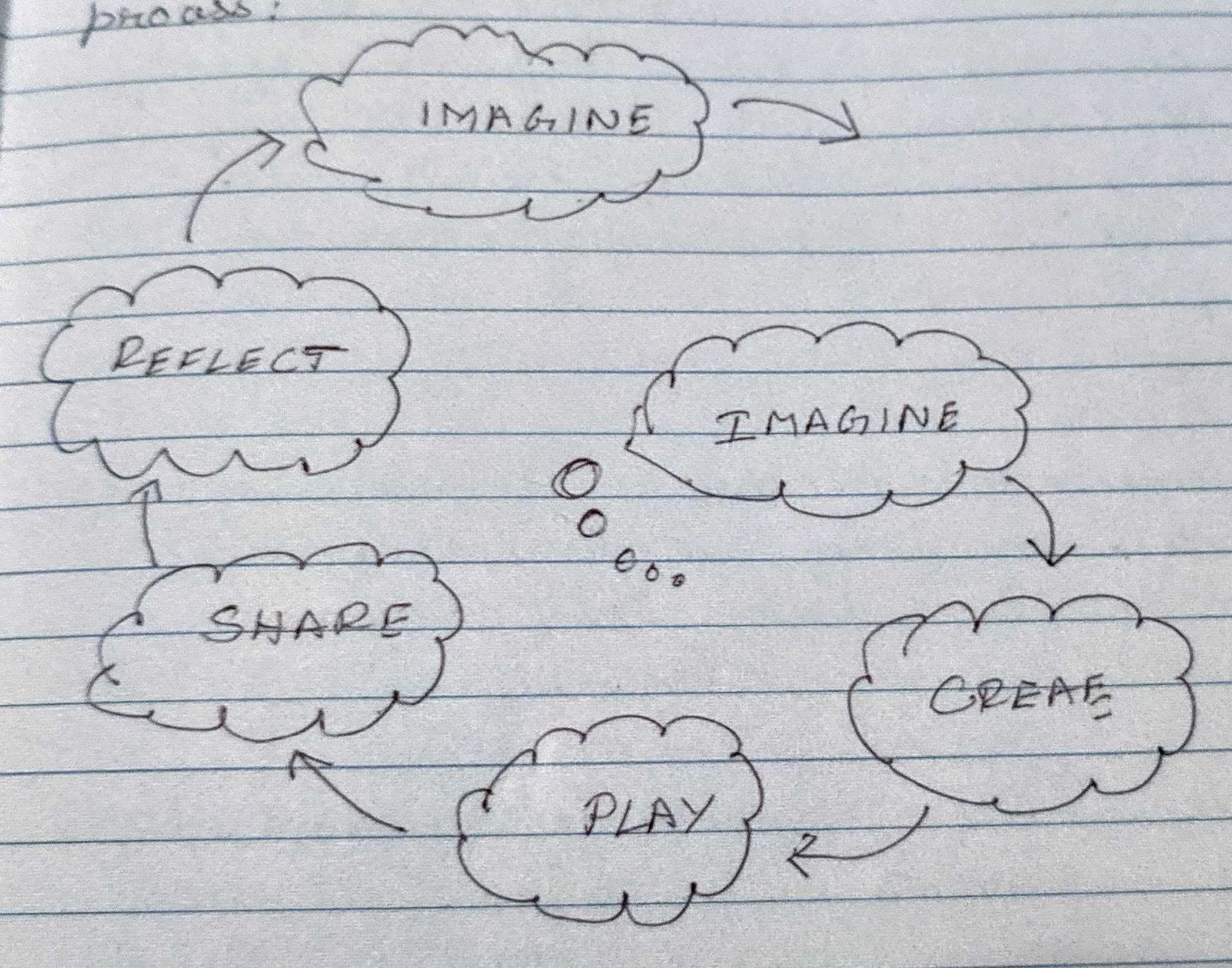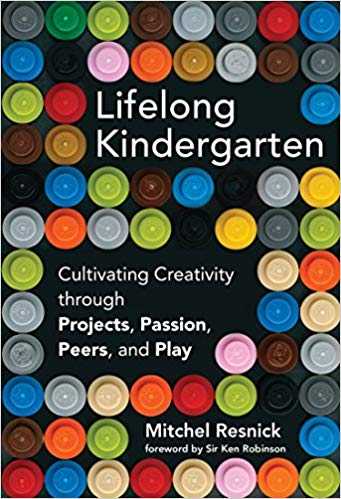Lifelong Kindergarten: Cultivating Creativity through Projects, Passion, Peers, and Play
by: Mitchel Resnick, Ken Robinson
Check out the book on Amazon | your public library.
27 Highlights | 3 Notes
In all, Froebel created a collection of 20 toys, which have become known as Froebel's gifts
I like to think of the creative process in terms of a Creating Learning Spiral. As kindergarten children play with blocks, build castles, and tell stories, they engage with all aspects of the creative process.

In short, we believe the best way to cultivate creativity is to support people working on Projects based on their Passions, in collaboration with Peers and in a Playful spirit.
I also agree that you can't teach creativity, if Teach means giving children a clear set of rules and instructions on how to be creative.
But you can Nurture creativity. All children are born with the capacity to be creative, but their creativity won't necessarily develop on its own. It needs to be nurtured, encouraged, supported.
But you can Nurture creativity. All children are born with the capacity to be creative, but their creativity won't necessarily develop on its own. It needs to be nurtured, encouraged, supported.
The focus shouldn't be on which technologies children are using, but rather what children are doing with them.
Risk-Takers, Doers, Makers of Things. These are X students, the creative thinkers. They've been the driving force for economic, technological, political and cultural change throughout history. Today, everyone needs to be a risk-taker, a doer, a maker of things - not necessarily to bend the arc of history, but to bend the arcs of their own lives.
Over the years, many educators and researchers have advocated Learning by Doing, arguing that people learn best when they are actively involved in Doing things, learning through hands-on activities.
But in the culture of the Maker movement, it's not enough to DO something: You need to MAKE something. According to the maker ethic, the most valuable learning experiences come when you're actively engaged in designing, building, or creating something — when you're learning through making.
But in the culture of the Maker movement, it's not enough to DO something: You need to MAKE something. According to the maker ethic, the most valuable learning experiences come when you're actively engaged in designing, building, or creating something — when you're learning through making.
How can you decide which toys are best for your children? Here's my advice: Ask not what the toy can do for your child; ask what your child can do with the toy.
With Scratch, children are always thinking in terms of projects. They are continually asking themselves: What type of project should I make? How can I improve it? What should I share with others? How should I respond to their comments and suggestions?
I've always loved the LEGO slogan: “Joy of building, Pride of Creation.”
In the process of writing, you learn to organize, refine and reflect on your ideas. As you become a better writer, you become a better thinker.
When discussing technologies to support learning and education, Seymour Papert often emphasized the importance go 'low floors' and 'high ceilings'. For a technology to be effective, he said, it should provide easy ways for novices to get started (low floors) but also ways to work on increasingly sophisticated projects over time (high ceilings).
… wide walls … It's not enough to provide a singe path from a low floor to a high ceiling; it's important to provide multiple pathways.
Seymour Papert used the term Hard Fun to describe this type of learning. Too often, teachers and educational publishers try to make lessons easier, believing that children want things to be easy. But that's not the case. Most children are willing to work hard — eager to work hard — so long as they're excited about the things they're working on.
The best learning experiences go through alternating phases of immersion and reflection. Developmental psychologist Edith Ackerman described the process in terms of Diving In and Stepping Back.
But it's also important for people to step back and reflect on their experiences. Through reflection, people make connections among ideas, develop a deeper understanding of which strategies are the most productive, and become better prepared to transfer what they've learned to new situatuions in the future.
Finding the right balance between freedom and structure is the key to creating a fertile environment for creative learning. That's true in Clubhouses, but also in classrooms, homes, libraries, museums and all other settings.
With too much strucutre, young people cannot work on what they want to work on. With too little structure, many aren't able to come up with ideas or follow through on ideas. Karen rejects the idea that structure and agency should be seen in opposition to each other. She argues for the “best of both the worlds”, proposing learning environments that “employ structure in a way that amplifies learner agency”
There's an old saying that a teacher should be a “guide on the side”, not a “sage on the stage.”
I've been particularly inspired by John Dewey, whi shifted the focus from play (the activity) to playfulness (the attitude). He explained: “Playfulness is a more important consideration that play. The former is an attitude of mind; the latter is a passing outward manifestation of this attitude.”
They described some children as Patterners and others as Dramatists. Patterners are fascinated by structures and patterns, and they typically enjoy playing with blocks and puzzles. Dramatists are more interested in stories and social interactions, and they often play with dolls and stuffed animals.
Learners difffer from one another in many ways: Some are patterners, others are dramatists; some are planners, others are tinkerers; some prefer to express themselves through text, others through images.
“If you're not prepared to be wrong, you'll never come up with anything original.”
10 tips for parents and teachers
- IMAGINE - Show examples to spark ideas.
- IMAGINE - Encourage messing around
- CREATE - Provide a wide variety of materials.
- CREATE - Embrace all types of making. … Even better: Encourage children to engage in multiple types of making. That way, they'll get an even deeper understanding of the creative process.
- PLAY - Emphasize process, not product.
- PLAY - Extend time for projects.
- SHARE - Play the role of matchmaker.
- SHARE - Get involved as a collaborator. … There is a sweet spot in between where adults and children form true collaborations on projects. When both are committed to working together, everyone has a lot to gain.
- REFLECT - Ask (authentic questions).
- REFLECT - Share your own reflections.
We need to break down barriers across disciplines providing students with opportunities to work on projects that integrate science, art, engineering, and design. We need to break down barriers across age, allowing people of all ages to learn with and from one another. We need to break down barriers across space, connecting activities in school, community centers, and homes. And we need to break down barriers across Time enabling children to work on interest-based projects for weeks or months or years, rather than squeezing projects into the constraints of a class period or curriculum unit.
